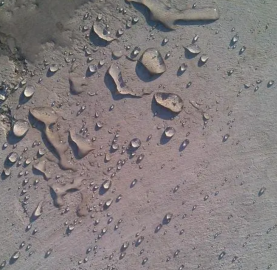The rapid development of the concrete industry has resulted in higher requirements for the admixtures used in concrete, especially the performance of water-reducing agents. Polycarboxylic Acid high-performance water-reducing agent is the latest generation of water-reducing agent, its high water reduction rate, good dispersion performance, and plasticity allow it to rapidly expand the application. Why use silicone defoamers in the concrete industry?
Due to the characteristics of the molecular structure of Polycarboxylic Acid water reducing agent, it introduces more air bubbles and uneven size when mixing concrete, which affects the quality of concrete, and it is necessary to add silicone defoamer to improve the foam control performance of concrete to meet the production demand. Silicone defoamer and polycarboxylic acid water-reducing agent compounding, its compatibility with water-reducing agent, and the water-reducing agent's water reduction rate of impact is small. Defoamers (added to silicone oils and silicone resin) are widely used in many industrial processes, chemical processing, and food processing.
The following six aspects of the application of silicone in the concrete industry:
- What kinds of defoamers are there?
- How to choose defoamers?
- What are the features of silicone defoamer?
- What is the principle of silicone antifoam agent?
- What are the precautions when using silicone defoamer?
- How to make silicone defoamer perform better?
1. What kinds of foam control agents?
Commonly used defoamers can be divided into silicone (resin), surfactants, alkanes, and mineral oils according to the different components.
(1) Silicone (resin)
Silicone-based defoamers also called emulsion antifoam agents, use silicone resin with emulsifier (surfactant) emulsification dispersed in aqueous systems.
![]()
XJY-6010/XJY-6011/XJY-6012 Methyl MQ Silicone Resin is a solid powder resin. This resin can provide good antifoaming and hydrophobic properties and eliminate existing foam.

(2) Surfactant type
This kind of antifoam agent is an emulsifier, it uses the dispersing effect of surfactant to keep the foam-forming substance dispersed in water in a stable emulsified state, thus avoiding the generation of foam.
(3) Chain alkanes
Chain alkane antifoam agent is an emulsifier to the chain alkane wax or its derivatives emulsified dispersion made of antifoam agent, its use is similar to emulsified antifoam agent.
(4) Mineral oil
Mineral oil is the main antifoaming ingredient. To improve the effect, sometimes mixed with metal soap, silicone oil, silica, and other substances used together. In addition, to make the mineral oil easy to diffuse to the surface of the foaming liquid, or to make the metal soap and others uniformly dispersed in the mineral oil, sometimes can be added various surfactants.
2. How to choose defoamers?
The choice of defoamer should be in line with the following points:
(1) Insoluble or soluble in the foaming liquid
In order to break the foam, the antifoam agent should be concentrated and centralized on the bubble film. In the case of a foam-breaking agent, it should be concentrated and centralized in an instant, and in the case of foam suppression, it should be kept in this state frequently. So the antifoam agent is supersaturated in the foaming liquid, only insoluble or insoluble is easy to reach the supersaturated state. Insoluble or insoluble, it is easy to gather in the gas-liquid interface, and it is easy to concentrate in the bubble film, in order to play a role in the lower concentration. Antifoam agent for the water system, the molecules of the active ingredient must be strong hydrophobic and weak hydrophilic, HLB value in the range of 1.5-3, the role is the best.
![]()
(2) Surface tension lower than the foaming liquid
Only the defoamer intermolecular force is small, the very low surface tension is lower than the foaming liquid, and the defoamer particles can be immersed in the bubble film and expand. It is worth noting that the surface tension of the foaming solution is not the surface tension of the solution, but the surface tension of the foaming solution.
(3) A certain degree of affinity with the foaming solution
As the defoaming process is actually a competition between the foam collapse rate and the foam generation rate, the defoamer must be able to quickly disperse in the foaming solution in order to quickly play a role in a wider range of foaming solutions. To make the defoamer diffusion faster, the defoamer active ingredient must have a certain degree of affinity with the foaming liquid. Antifoam agent active ingredients and foaming liquid too pro will dissolve; too sparse and difficult to disperse. Only if the affinity is appropriate, the effectiveness will be good.
(4) No chemical reaction with the foaming liquid
On the one hand, defoamer will lose its effect, on the other hand, may produce harmful substances, affecting the growth of microorganisms.
![]()
3. What are the features of silicone defoamer?
Aiming at the blistering characteristics of the cement mortar mixing process, silicone defoamer can effectively solve the problem of insufficient strength of concrete due to high air content, and it has a strong bubble-breaking effect on the bubbles that have already been generated, so as to make the concrete components denser and brighter. Relevant silicone defoamer is not only widely used in mortar, and concrete defoaming, but also applicable to coatings, dyes, inks, and other materials in the defoaming.
(1) Good dispersion and rapid defoaming in cement mortar system
(2) Low dosage and high efficiency.
(3) Increase the strength and brightness of concrete components
(4) This product is non-toxic, odorless, and conducive to production safety.
![]()
4. What is the principle of silicone defoamer?
(1) Foam local surface tension reduction leads to foam bursting
The origin of this mechanism is to sprinkle high-grade alcohol or vegetable oil on the foam, when it dissolves into the foam liquid, it will significantly reduce the surface tension of the place. Since these substances are generally less soluble in water, the low surface tension is limited to controlling foam, while the surface tension around the foam remains almost unchanged. The part with reduced surface tension is strongly pulled and extended in all directions and finally ruptures.
(2) Destruction of membrane elasticity leading to bubble bursting
Antifoam agents added to the foam system will diffuse to the gas-liquid interface so that the surfactant with the role of foam stabilization makes it difficult to restore the ability of membrane elasticity.
(3) Promote liquid film drainage
Antifoam agents can promote the liquid film discharge, thus leading to bubble bursting, the rate of foam discharge can reflect the stability of the foam, add a material to accelerate the foam discharge, and can also play a role in defoaming.
(4) Adding hydrophobic solid particles can lead to bubble bursting
The hydrophobic solid particles on the surface of the bubbles will attract the hydrophobic end of the surfactant, so that the hydrophobic particles produce hydrophilicity and enter the aqueous phase, thus playing the role of antifoam.
(5) Solubilizing anti-foaming surfactants can lead to bubble bursting
Some low molecular substances that can mix well with the solution can solubilize the surfactant and reduce its effective concentration. This effect of low molecular substances such as octanol, ethanol, propanol, and other alcohols, not only can reduce the surfactant concentration of the surface layer, but also dissolve into the adsorption layer of the surfactant, reducing the degree of compactness of the surfactant molecules, thus weakening the stability of the bubble.
![]()
(6) Electrolyte disintegration of surfactant bilayer
For the foam with the help of the surfactant bilayer interacting with each other, resulting in the stability of the foaming liquid, ordinary electrolytes can disintegrate the surfactant bilayer to play an antifoaming role.
5. What are the precautions when using silicone defoamer?
The strength of concrete is mainly affected by the air content of concrete after adding defoamers and air-entraining agents.
With the increase of defoamer dosage, the air content and water reduction rate of concrete decreases, and in serious cases, there will be water seepage and bottoming, which will make the concrete easier to use, so there is an optimal dosage range of defoamer.
We should pay attention to three points in the use process:
(1) Defoamer used in polycarboxylate series water reducing agent production of concrete will reduce the air content of polycarboxylate water reducing agent, the concrete paste will be more viscous, it is recommended to mix air-entraining agent after mixing defoamer, eliminating uneven large bubbles in the polycarboxylate, introducing uniform small bubbles, which can increase the ease of concrete.
(2) Anti-foaming agent has strong dispersion with water and admixture, and it is easy to be separated after a long time. It is recommended to mix continuously during this period.
(3) The performance of the defoamer may be degraded by alkali, so please avoid using it under the condition of a pH value over 10.
6. How to make silicone defoamer perform better?
Most of the defoamers used in concrete mortar are silicone-based compounds. Silicone antifoam agent has a wider application scope and better effect, which can eliminate the excess unwanted foam in concrete and make the appearance of concrete more beautiful, meanwhile, it improves the pore structure and compactness of concrete due to the reduction of the air content of polycarboxylic acid water reducing agent. How to improve the competitiveness of your products?
XJY Silicones is one of the leading silicone MQ resin and VMQ silicone manufacturers in China, with more than 30 years of R&D and manufacturing experience in the silicone industry as well as more than 15 related patents and technical support. Our silicone raw material products can meet the needs of the defoamer field and support the provision of diversified customized solutions.



